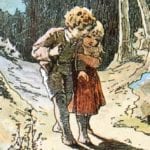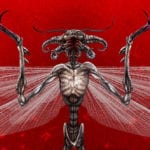 Mysteries
Mysteries  Mysteries
Mysteries  History
History 10 Surprising Stories About the Texas Rangers
 Humans
Humans 10 Philosophers Who Were Driven Mad by Their Own Theories
 Miscellaneous
Miscellaneous 10 Video-Game-Worthy Weapons and Armors from History
 Weird Stuff
Weird Stuff 10 Psychics Who Accurately Predicted Wartime Events
 The Arts
The Arts 10 Pieces of Art Inspired by a Broken Heart
 Health
Health 10 Science Fiction-Sounding New Medical Treatments
 History
History 10 Surprising Facts About the Father of Submarine Warfare
 Space
Space Ten Astonishing New Insights into Alien Worlds
 Weird Stuff
Weird Stuff 10 Bizarre Summer Solstice Rituals Still Practiced Today
 Mysteries
Mysteries Top 10 Haunting Facts About the Ghost Ship MV Alta
 History
History 10 Surprising Stories About the Texas Rangers
 Humans
Humans 10 Philosophers Who Were Driven Mad by Their Own Theories
Who's Behind Listverse?

Jamie Frater
Head Editor
Jamie founded Listverse due to an insatiable desire to share fascinating, obscure, and bizarre facts. He has been a guest speaker on numerous national radio and television stations and is a five time published author.
More About Us Miscellaneous
Miscellaneous 10 Video-Game-Worthy Weapons and Armors from History
 Weird Stuff
Weird Stuff 10 Psychics Who Accurately Predicted Wartime Events
 The Arts
The Arts 10 Pieces of Art Inspired by a Broken Heart
 Health
Health 10 Science Fiction-Sounding New Medical Treatments
 History
History 10 Surprising Facts About the Father of Submarine Warfare
 Space
Space Ten Astonishing New Insights into Alien Worlds
 Weird Stuff
Weird Stuff 10 Bizarre Summer Solstice Rituals Still Practiced Today
Top 10 Truly Disturbing Fairy Tales
The horribly disturbing fairy tales featured on this list involve torture, rape, cannibalism, infanticide, necrophilia, bestiality, cruel and unusual punishment, and incest – all of them taboo subjects in today’s sterilized society. Many consider them unsuitable reading material for 21st century children, with their sunny dispositions and delicate, impressionable minds.
Cringe-inducing though such subjects may be to many modern parents, they were often common themes in fairy tales – enjoyed by children and adults alike over the centuries.
Many people try to a find a moral lesson hidden behind the brutalities depicted in these disturbing fairy tales: Little Red Riding Hood is a metaphor for the dangers of puberty; Bluebeard is a symbol of sexual curiosity. But I’m not so interested in the hidden messages, the morals or the justifications. I am just a lover of bizarre little yarns – a fairytale fanatic – and here today I would like to share with you some of the most disturbing tales that I have come across.
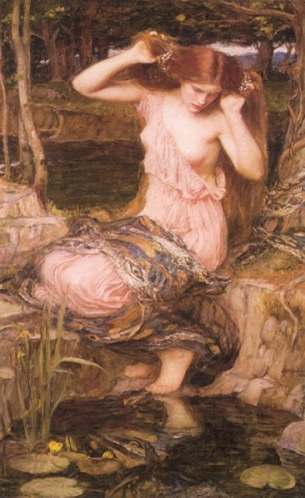
Features: Bestiality, unnatural pregnancy, dismemberment/bodily mutilation, death by being burned alive.
While a woman sleeps in the garden, a snake crawls under her skirts and makes its way ‘into her body’ where it comes to rest in her womb. The woman falls pregnant, and when the baby (Biancabella) is born, she has a tiny snake coiled around her neck. The snake quickly slithers away into the garden.
When Biancabella is 10, she discovers the snake in the garden. The snake reveals itself to be her own sister, and gifts her with great beauty. With her new beauty, she is quickly married off to a king.
The king’s evil step-mother hatches a plan to be rid of Biancabella, and when the king is away at war, she pays a group of men to take the new queen into the forest and kill her. The men are unable to go through with the murder, so instead they cut off Biancabellas hands and tear out her eyes, which they give to the step-mother as proof of the queen’s demise. The step-mother then places her own hideously ugly and deformed daughter in Biancabella’s bed, and when the king returns home, she tells him that his precious Biancabella miscarried a child, and has become hideous with grief.
Meanwhile, Biancabella decides to kill herself – but as soon as she attempts to do so, her sister appears in human form and magically heals Biancabella’s horrible wounds. They return to the kingdom where the false queen now reigns: the evil plot is revealed, and the step-mother and her two daughters are burned alive in a furnace.
-(Giambattista Basile – Il Pentamerone (Entertainment For The Young) 1634)
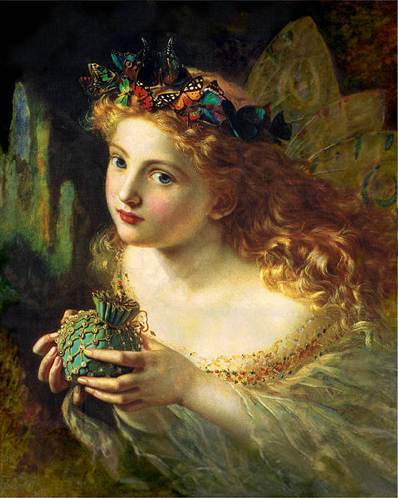
Features: Unnatural birth, murder, dismemberment, death by angry prostitutes, execution by being buried alive in the sewer
A peasant woman gives birth to a stick of myrtle, which a prince then purchases for a great price. It turns out that a stunningly beautiful fairy lives within the myrtle stick, and soon begins sneaking into the prince’s bed in the dark to ‘play at mute sparrow’ with him. The prince takes her for his secret lover, after she confesses that she is a slave to his every whim and desire.
Sadly – the Prince being entirely satisfied by the fairy – seven of his former prostitutes now find themselves out of work. So when the Prince is away on business, they sneak into his bedchambers and discover his fairy lover. The enraged prostitutes smash the fairy’s head open, and break her body into pieces. They all take a piece of her corpse – except the youngest, who takes only a single lock of golden hair. All that is left of the unfortunate fairy are her teeth, hands, blood and some bones. A servant, who was entrusted to water the myrtle, finds the grisly mess and buries it in the pot under the myrtle tree.
The fairy manages to grow a new body from the buried flesh and bones, and reveals to the Prince her murderers’ identities. The prostitutes are all buried alive in the public sewer, save the youngest, who is married to the servant.
-(Giambattista Basile. Il Pentamerone (Entertainment for the Young) 1634)
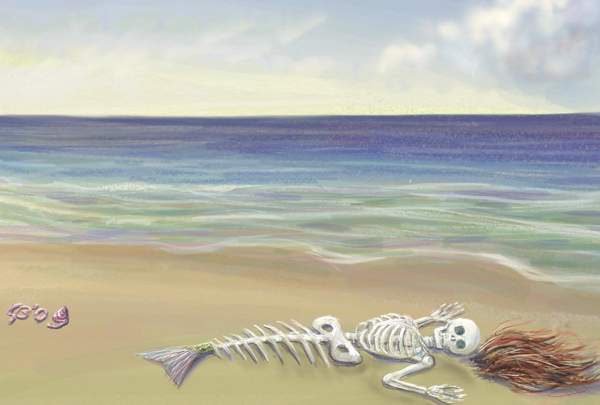
Features: Mutilation, long-term suffering, suicide
A young, beautiful mermaid falls in love with a dashingly handsome human prince, after saving him from drowning. In the hope of winning the prince’s heart, she asks the sea witch for a pair of human legs. The witch agrees to give the mermaid the most beautiful pair of legs known to man. But there’s a catch: every step the mermaid takes will feel like it was taken on razorblades – her feet will bleed ceaselessly. And even worse, her greatest possession – a beautiful mermaid voice – will forever be silenced. But the mermaid, in love with the Prince, agrees to the deal.
The next morning, the prince finds the mermaid washed up on the shore, naked, with her beautiful new human legs. Long story short, he marries another woman. The mermaid, after toying with the idea of killing the Prince, eventually throws herself into the ocean and dies.
I always preferred this version over Disney’s rendition. Some children might beg to differ.
-(Hans Christian Anderson – Fairy Tales 1839)

Features: Incest, infanticide, extremely cruel and unusual punishment/torture, death by being quartered
Evil Prince Tebaldo vows to kill his only daughter Doralice, after she refuses to marry him. The terrified Doralice, having learned of her incestuous father’s intentions, hides inside a wooden chest which Prince Tebaldo sells to a merchant. She remains in the chest for months, but is kept alive by a magical elixir given to her by her kindly old nurse. The chest ends up being sold to a king, who catches Doralice sneaking out of it and – rather spontaneously – makes her his wife.
Prince Tebaldo manages to track Doralice down. His disguise is so good that she doesn’t recognize her evil father, and lets him sleep in the nursery with her newborn infant twins. Tebaldo slaughters the twin babies, and pins the crime on Queen Doralice herself. Her enraged husband has the unfortunate queen buried up to her neck in the ground. She is to be fed and watered to prevent her dying of starvation, so her body can be slowly eaten alive by worms. Eventually, Tebaldo’s crime is revealed: Doralice is removed from the ground, more dead than alive, and Tebaldo is tortured, quartered and fed to the dogs.
Presumably, they all live happily ever after – though Doralice was probably in need of some therapy.
-(Giovanni Francesco Straparola – The Facetious Nights of Straparola 1550ish)

Features: Coma sex/rape, attempted infanticide/forced cannibalism, death by burned alive alive
This was the earliest written version of Sleeping Beauty. It is prophesied at Talia’s birth that she will one day face great danger from a chip of flax. Her father therefore orders that all flax be removed from the kingdom. When she is grown, Talia manages to find the only piece of flax in the entire kingdom, gets a splinter of it stuck beneath her fingernail, and falls into a deathlike sleep. Her father, beside himself with grief, orders the palace and surrounding countryside be abandoned so he can put the event out of his mind.
Eventually, another king stumbles upon the abandoned kingdom, and finds Talia sleeping alone. Unable to wake her, he decides to rape the sleeping girl. He then returns home to his wife.
Talia falls pregnant and, without waking, eventually gives birth to twins.. While the babies try to find her breasts to suckle, one starts sucking on her finger and the flax splinter is loosened. Talia wakes up, and is overjoyed to find herself the mother of twins, which she names Sun and Moon.
The king decides to return for a little more action, but instead of finding a comatose girl, he finds Talia awake – the mother of his children. A relationship soon develops between them. The king’s wife learns of the affair and, pretending to be the king, sends for Sun and Moon. She gives them to the cook, and tells him to slaughter and roast them and serve them to the king. The cook, unable to kill the babies, hides the twins and serves up two baby lambs instead. The queen watches gleefully as the king devours the meal. She then sends for Talia, and demands she be burned alive. The King hears Talia screaming, and rescues her just in time. The awful queen is thrown in the fire instead, and roasts to death. The cook then produces the twins, alive and well, and they all live happily ever after.
-(Giambattista Basile – Il Pentamerone (Entertainment For The Young) 1634)

Features: Old lady sex, death by being skinned alive.
This one may be rather long, but believe me: it’s a story worth reading. A king mistakenly believes that two hideous, smelly, deformed old women are actually the most delicate, beautiful and scrumptious of young tender maidens.
As you might expect, he has never actually laid eyes on them, since (fortunately for them) they’re hidden behind a large wall – but he becomes so passionately aroused after kissing one of the old woman’s fingers through the keyhole in the gate, that he begs to be able to spend the night with her. She agrees to bed him, but only if he will take her in the dark – since, according to herself, she is ‘far too modest to expose her nakedness to him’. The king rushes home to wait in anticipation for night to fall and his love to come to him.
In an attempt to make herself feel more youthful to the king’s touch, the old woman takes all her loose, sagging skin and ties it behind her back with string. She then covers herself with a long shroud, and limps in the dark to the king’s chambers.
After he has finished ‘the deed’ and she’s fallen asleep, the king discovers the secret his ‘tender maiden’ has hidden behind her back, and after lighting a candle he finds that his bed-mate is actually a disgusting old hag. He freaks out and throws her out the window (as you do).
Luckily the old woman has so much loose, sagging skin that she gets caught in the branches of a nearby tree and is left hanging there. Some fairies fly by and find the sight of the old woman so funny that they endow her with gifts of wondrous beauty, intelligence, and youth as a reward; she now has the body and face of a 15 year old! The king looks out his bedroom window in the morning, discovers a stunningly beautiful girl sitting in his tree, and immediately takes her for his wife.
The new queen, not wanting to reveal her beauty secret to her sister, tells the old hag that she has had herself skinned alive. The remaining old woman – presumably not wanting to be left out – takes herself quick-smart to the nearest barber shop, and requests that she also be skinned alive. When the barber has removed her skin down to her navel, the old woman dies of blood loss and pain (letting out a big fart as she does so) and her sister and the king live happily ever after.
The moral of the story? Something to do with the vanity of aging women I guess – but regardless of the moral, that is one damn bizarre fairy tale.
-(Giambattista Basile – Il Pentamerone (Entertainment For The Young) 1634)
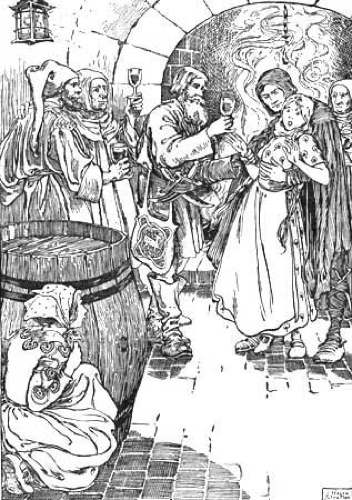
Features: Murder, dismemberment, cannibalism
A miller marries his only daughter to a man who seems to be very respectable and well-off. The young woman visits her groom for supper, but finds his house empty. Empty, that is, save for a bird that keeps telling her to leave, and an old woman who tells her that her bridegroom is actually a murderous cannibal, who eats his young brides and pretty much any other maiden he can get his hands on. The old lady then quickly hides the young woman behind a barrel. From her hiding place, the bride-to-be watches as her bridegroom and a group of men return home drunk, dragging a beautiful young maiden with them, who is screaming and crying. Ignoring her pleas, they force the maiden to drink three different colored wines, after which her heart ‘bursts in two’. The group of men then strip her naked and begin to dismember her body, sprinkling her flesh with salt in preparation to cook and eat it.
One of the unfortunate victim’s fingers, adorned with a golden ring, rolls behind the barrel where the bride-to-be is hiding. She puts the severed digit in her pocket, then witnesses the entire macabre feast. When the men all fall into a drunken stupor, she creeps out over their prone bodies and runs all the way home.
The bridegroom is exposed for the monster he is when the bride-to-be produces the dead girl’s finger at their wedding. He and his gang of murderers are all swiftly executed.
-(The Brothers Grimm – Children’s and Household Tales 1812)
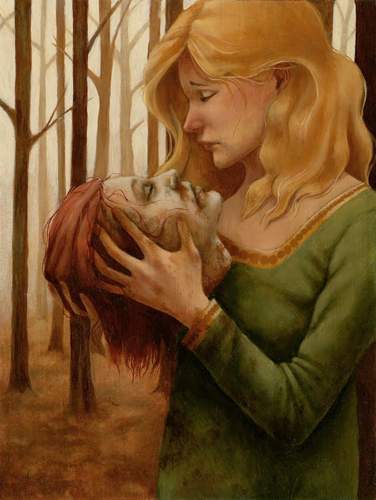
Features: Murder, beheading, quite-possibly-incestuous domestic abuse, ‘mild’ necrophilia, death by flowers
A young woman’s lover is stabbed to death, beheaded, and buried, by her wicked and possessive brother. After committing the murder, the brother is described as ‘entering the beautiful, blooming girl’s bedroom as she lies dreaming of her lover, and bending over her, laughing hideously as only a fiend can laugh as he does so’. This could mean he just stands at the foot of her bed and laughs, but it could also represent something a lot more sinister.
As the brother was burying the corpse, a dry leaf settled in his hair. A tiny elf, who witnessed the brutal act, hid under this leaf, which then settled on the girl’s bed as her brother ‘bent over her’. The elf climbs into the girl’s ear, tells her of her lover’s murder, and informs her where the body lies. The girl wakes up, broken-hearted, and goes into the woods to dig up her lover’s head. She shakes the earth out of his hair, kisses his cold, dead lips, and carries the severed head home with her. She puts the head in a large flower pot, covers it in earth, and plants a twig of jasmine over it.
She weeps over the pot day and night, and the jasmine twig begins to grow beautiful flowers. Seeing his sister constantly kissing these flowers, the brother is furious, thinking she is going mad.
The girl eventually dies a quiet death. The elf hides in her ear and whispers sweet stories about her lover to comfort the girl as she dies. The brother carries the flower pot into his bedroom, and as he sleeps, tiny spirits come out of the flowers and kill him with spears to avenge the dead lovers. The murdered man’s skull is later discovered in the flower-pot, and the evil deed is uncovered. Weird huh?
-(Hans Christian Anderson – Fairy Tales 1839)

Features: Cannibalism, disturbing sexual content/paedophilia
Thought you knew Little Red Riding Hood? In this version, the big bad wolf rushes to Grandmother’s house after a little girl tells him she is delivering some milk and bread to the old woman. The wolf devours Grandmother; and after putting some of her flesh in the pantry and some of her blood into a bottle, he climbs into Grandmother’s bed. When the little girl arrives, the wolf calls from the bed: “Eat some of the meat in the pantry my dear, and drink some of the wine in the bottle’’ – and the girl proceeds to devour the grisly meal. As the girl eats, a little cat sings: “It is a slut that eats and drinks of her own grandmother’s flesh and blood!’’
The wolf then forces the little girl to burn all of her clothes, and climb into bed naked with him. After feeling his hairy body, his big shoulders and noticing his large teeth, she realizes it is not her grandmother she is in bed with at all, and tells the wolf she needs to go outside quickly to take a pee. He ties a bit if woolen yarn around her ankle so she cannot escape, but she ties the yarn around a tree and runs home naked. The wolf, growing impatient, calls out “Are you taking a dump child?” Not hearing any answer, he leaps out of bed and runs after the girl, but his plans are foiled when she makes it home before he catches her. No little girl for this big bad wolf tonight.
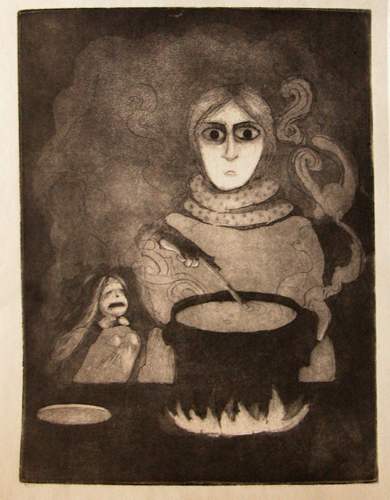
Features: Filicide (parent/child murder), dismemberment, parent/child cannibalism – pretty horrific content all round
An evil woman hates her step-son so much that she hatches a plan to be rid of him, and to thereby secure her husband’s inheritance for their young daughter alone.
Feigning kindness to the little boy, his step-mother bids him reach into a chest to fetch an apple. As he reaches in, she slams the lid of the chest down on his neck, and his head is chopped off.
She then props the child’s body up in a chair and places the head back on his corpse, covering the wound with a handkerchief. His little sister Marlene arrives, and the mother tells the girl that if her big brother won’t answer her, she should cuff him around the ears. Unable to get an answer from her big brother, Marlene smacks him in the face and his head falls off.
Marlene becomes hysterical, believing she has killed her brother. Her mother comforts her, saying that they will hide the dead boy in a stew and no one will be any wiser. So they proceed to chop up the little boy’s body, and put the pieces into a pot – skin, bones and all. Marlene cries so much during the horrific act that the stew does not need salt, for her tears have seasoned the meal beautifully.
When the father returns home, his wife explains that the boy has gone on holiday to the countryside, and she dishes up the macabre feast for him. The father greedily devours his own child, proclaiming that this is the best food he has ever eaten; he noisily sucks the meat off the bones which he then throws under the table. Marlene cries ceaselessly as she watches her father devour her brother. When the father has finished eating, the little girl gathers up her brothers bones from under the table and places them beneath the juniper tree where the boy’s dead mother is buried. A beautiful bird flies out of the tree, and begins to fly around the countryside singing “My mother killed me, my father ate me!’’
This bird eventually kills the step-mother, and from the woman’s burning remains the little boy appears, alive again. The father, brother and sister walk hand-in-hand into the house, and sit down at the table together to eat lunch. The end. Now that’s one f***** up fairy tale!
-(The Brothers Grimm – Children’s and Household Tales 1812 )
